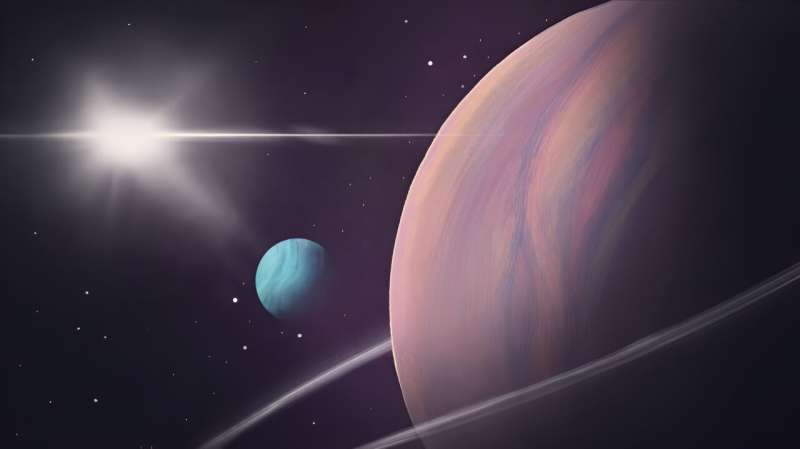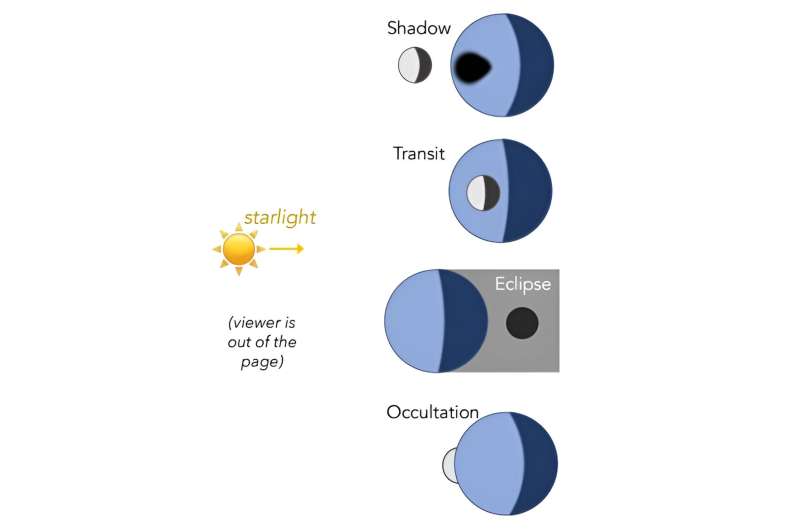This article has been reviewed according to Science X's editorial process and policies. Editors have highlighted the following attributes while ensuring the content's credibility:
fact-checked
preprint
trusted source
proofread
The habitable worlds observatory could see lunar and solar 'exo-eclipses'

A future space observatory could use exo-eclipses to tease out exomoon populations.
If you're like us, you're still coming down from the celestial euphoria that was last month's total solar eclipse. The spectacle of the moon blocking out the sun has also provided astronomers with unique scientific opportunities in the past, from the discovery of helium to proof for general relativity. Now, eclipses in remote exoplanetary systems could aid in the hunt for elusive exomoons.
A recent study out of the University of Michigan in partnership with Johns Hopkins APL and the Department of Physics and the Kavli Institute for Astrophysics and Space Research at the Massachusetts Institute of Technology entitled "Exomoons & Exorings with the Habitable Worlds Observatory I: On the Detection of Earth-Moon Analog Shadows & Eclipses," posted to the arXiv preprint server, looks to use a future mission to hunt for eclipses, transits and occultations in distant systems.
Hunting for exomoons
"HWO is likely to be able to detect exomoons using a variety of detection methods, unlike existing observatories," Mary Anne Limbach (University of Michigan) lead author on the study told Universe Today. "In a system where we detect an exomoon via an exo-eclipse, we might be able to observe other signatures, such as light from the moon within the combined reflected light spectrum of the moon and the planet."
The proposed Habitable Worlds Observatory (HWO) was derived from the LUVOIR-B (Large Ultraviolet Optical and Infrared explorer) concept. This was highlighted in the Astro2020 Decadal Survey for space-based astronomy. HWO would work from the sun-Earth L2 Lagrange point (the current home for Euclid and JWST), and launch on either an SLS or Falcon Heavy sometime in the mid-2030s.
HWO would employ a free-flying "star-shield," allowing it to observe exoplanets orbiting stars directly. But what's really enticing to observers is the idea of seeing large moons orbiting said planets. Thus far, claims of exomoon detections such as Kepler-1625b and Kepler-1708b have remained elusive. If, however, these moons orbit along their respective ecliptic planes, we'd see tell-tale dips in brightness as these moons pass into the planet's shadow, then cast their shadows back on the host primary.
Eclipses, transits and occultations
In astronomy, we call this eclipse-transit pattern a series of mutual events, as one body passes in front of another. In our own solar system, Jupiter is a prime example of this. Earth and the moon experience similar sorts of events twice a year during what are known as eclipse seasons.

"HWO's primary mission is to search for signatures of life on planets orbiting other stars. To achieve this, HWO will need to observe many nearby star systems, sometimes for several days at a time," says Limbach.
"During these observations, HWO will measure the reflected light from the directly imaged planets in the system. If an exo-eclipse (or transit) occurs during this time, we would observe significantly less light from the planet during the eclipse (up to about 30% less for an Earth-moon analog, depending on the orbital phase)."
We already have some idea what an "exo-eclipse" or transit event might look like from a distance. In 2008, NASA repurposed the Deep Impact spacecraft for what was known as the EPOXI (a combination of two acronyms: the Deep Impact Extended Investigation and the Extrasolar Planet Observation and Characterization missions). Looking back at the Earth-moon system, EPOXI saw a series of transits. These give researchers some idea just what such an event might look like.
Looking for Earth analogs
The Habitable Worlds Observatory would work in the near-infrared, a band where large moons may outshine their host worlds. With an Earth-moon analog system, HWO is expected to see 2–20 mutual events out to 10 parsecs distance. Larger gas giant events might be detectable out to 20 parsecs away.
"Since multiple exomoon detection methods will be available to HWO and we predict that these will facilitate exomoon detection, HWO may be capable of revealing general information about exomoons as a population, such as how common or rare large moons around Earth-like planets are, or the physical circumstances under which exomoons are readily found," says Jacob Lustig-Yager (University of Washington). "If HWO is able to detect many exomoons, then this may open the door to such population studies in the future."
To be sure, detection of exomoons via the exo-eclipses they produce will be difficult. This will represent the very cutting edge of what even the Habitable Worlds Observatory is capable of. This method will also have to contend with false signals. These include possible "exo-rings" and even weather variability and rotation changing the albedo or overall brightness of the host primary.
On the plus side, researchers note that younger systems should produce more mutual events. Think of the Earth-moon system early in its history when the moon was first ripped from the Earth and was much closer. This primordial moon would've loomed large in the sky, producing lots of eclipses.
A population of exomoons
"The next aspect we are investigating is the spectroscopic detectability of 'Earth-like' moons orbiting gas giant planets in the habitable zone," says Limbach. "While such moons have often been imaged in popular culture (e.g., Endor and Pandora), HWO may be the first observatory capable of detecting and characterizing them, should they exist."
Ultimately, the methods described could lead to detection of an entire population of exomoons, allowing us to say with some authority just how common they are in the cosmos.
More information: Mary Anne Limbach et al, Exomoons & Exorings with the Habitable Worlds Observatory I: On the Detection of Earth-Moon Analog Shadows & Eclipses, arXiv (2024). DOI: 10.48550/arxiv.2405.02408
Journal information: arXiv
Provided by Universe Today




















